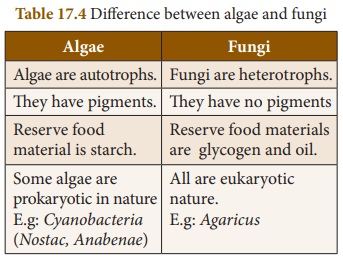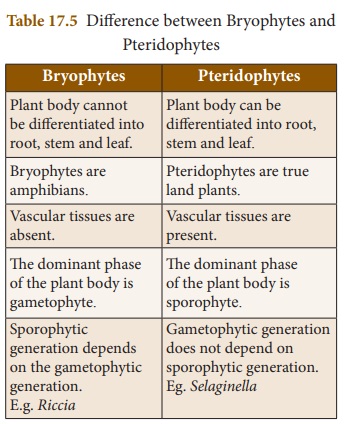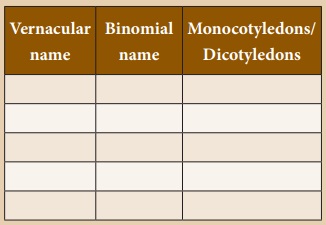Science : Chapter 17 : Plant Kingdom
TEXTBOOK EXERCISES
I. Choose the best answer.
1. Solanum trilobatum is the binomial name of Thoothuvalai. The word ‘Solanum’ refers to
a) Species
b) Genus
c) Class
d) Orders
[Answer: (b) Genus]
2. Floridian starch is a reserve food material of
a) Chloroplyceae
b) Phaeophyceae
c) Rhodophyceae
d) Cyanophyceae
[Answer: (c) Rhodophyceae]
3. An example for colonial form of algae is
a) Oscillatoria
b) Nostac
c) Volvox
d) Chlorella
[Answer: (c) Volvox]
4. One of the following is an edible mushroom
a) Polyporus
b) Agaricus
c) Pennicillium
d) Aspergillus
[Answer: (b) Agaricus]
5. Plants that prevent soil erosion are
a) algae
b) fungi
c) bryophytes
d) pteridophytes
[Answer: (c) Bryophytes]
6. The first land plants are
a) bryophytes
b) pteridophytes
c) gymnosperm
d) angiosperm
[Answer: (b) Pteridophytes]
7. The well-developed sporophytic plant body is seen in
a) bryophytes
b) pteridophytes
c) gymnosperms
d) angiosperms
[Answer: (c) Gymnosperms]
8. Binominal Nomenclature was first introduced in the year
a) 1970
b) 1975
c) 1978
d) 1623
[Answer: (d) 1623]
9. Penicillin is an antibiotic which is extracted from
a) algae
b) fungi
c) bryophytes
d) pteridophytes
[Answer: (b) Fungi]
II. Fill in the blanks.
1. The word ‘Taxonomy’ is derived from Greek.
2. Binomial nomenclature was first introduced by Gaspard Bauhin
3. The book ‘Genera Plantarum’ was published by Bentham and Hooker.
4. Monocotyledon seed bears only one cotyledon.
5. Brown algae belongs to phaeophyceae class.
6. Agar Agar is obtained from red algae.
7. The reserve food material of fungi are glycogen and oil.
8. The first true land plant is pteridophyte.
9. Xylem and phloem are absent in bryophyte plants.
10. Reticulate venation is present in dicot plants.
III. State true or false. If false, correct the statement.
1. In polypetalae, the petals are free. [Answer: True.]
2. Binomial name should contain more than two words. [Answer: False.]
Correct statement: Binomial name should contain two words.
3. Artificial system of classification is based on a few characters of the plant. [Answer: False.]
Correct statement: Artificial system of classification is based on the morphological characters of the plant.
4. Cell wall of fungi is made up of chitin. [Answer: True.]
5. Pinus is a closed seeded plant. [Answer: False.]
Correct statement: Pinus is a naked seeded plant.
6. All bryophytes are hydrophytes. [Answer: False.]
Correct statement: All bryophytes are amphibians.
7. Dicotyledons have well developed characters than the gymnosperms. [Answer: True.]
8. Mosses are the well developed plant in bryophytes. [Answer: True.]
9. The dominant phase of the bryophytes is sporophyte. [Answer: False.]
Correct statement: The dominant phase of the bryophytes is gametophyte.
10. The dominant phase of the pteridophyte is gametophytic phase. [Answer: False.]
Correct statement: The dominant phase of the pteridophytes is sporophvtic phase.
IV. Match the following.
1. Cyanophyceae – Green algae
2. Chlorophyceae – Blue green algae
3. Phaeophyceae – Red algae
4. Rhodophyceae – Brown algae
V. Answer very briefly.
1. Define – Thallus.
Answer: Thallus refers to a plant body which is not differentiated into roots, stem and leaves. Ex : Algae.
2. What is meant by binomial nomenclature? Give example.
Answer: The naming of an organism with two words are known as Binomial Nomenclature. For example, the binomial name of mango is Mangifera indica. Here the first word Mangifera refers to the genus name and the second word indica to the species name.
3. Write any two characters of dicotyledons.
Answer: (i) Seed has two cotyledons.
(ii) Plants have tap root system, leaves with reticulate venation.
(iii) Flowers are tetramerous or pentamerous. Calyx and corolla are well differentiated.
(iv) Pollination occurs mostly by insects.
4. Seeds of gymnosperm plants are naked. Why?
Answer: In gymnosperms, ovules are borne on megasporophylls and no flowers are produced. Therefore the seeds are described as naked. They are open seed bearing plants.
5. Write any two economic importance of fungi.
Answer:
(i) Mushrooms contain rich protein, minerals and are edible.
Ex : Agaricus.
(ii) The antibiotic penicillin is got from the fungus penicillium notatum. Other antibiotics like gentamycin, erythromycin are also got from fungi.
VI. Answer briefly.
1. Write a short note on natural system of classification.
Answer:
(i) In this system, plants are classified on the basis of several characters. Bentham and Hooker’s classification is an example of Natural System of Classification.
(ii) This system of classification is based on morphological and characters of seeded plants.
(iii) This classification is widely used in many Herbaria and botanical gardens all over the world.
(iv) Bentham and Hooker published their Natural system of Classification in their book named Genera Plantarum in 3 volumes.
2. Write any three economic importance of algae.
Answer:
(i) Agriculture :
Some of the blue green algae are essential for the fixing of atmospheric nitrogen into the soil, which increases the fertility of the soil, e.g. Nostoe, Anabaena.
(ii) Agar Agar:
Agar Agar is extracted from some red algae, namely Gelidium, Gracillaria, etc., which is used to prepare growth medium in laboratories.
(iii) Iodine:
Iodine is obtained from brown algae like Laminaria (kelp).
3. Write the differences between algae and fungi.
Answer:

Algae
1. Algae are autotrophs.
2. It has pigments.
3 Reserve food material is starch.
4. Some algae are prokaryotic in nature eg : Cyanobacteria (Nostac, Anabenae)
Fungi
1. Fungi are heterotrophs.
2. It has no pigments
3. Reserve food materials are glycogen and oil.
4. All are eukaryotic in nature, eg : Agaricus
4. How many classes are there in bryophytes? What are they?
Answer: Bryophytes are classified into 3 classes.
(i) Class I : Hepaticae (Liverworts)
Ex : Riccia.
(ii) Class II : Anthocerotae (Hornworts)
Ex : Anthoceros
(iii) Class III : Musci (Mosses)
Ex : Funaria
5. Write any four characters of pteridophytes.
Answer:
(i) The main plant body is sporophytes, which is the dominant phase, differentiated into true root, stem and leaves.
(ii) Sporophytes reproduce by means of spores. Spores are produced in sporangium.
(iii) The sporangia bearing leaves are called sporophyll.
(iv) Most of the plants produce only one type of spore, it may be either microspore or megaspore (homosporous).
VII. Answer in detail.
1. Draw the outline of Bentham and Hooker’s system of classification.
Answer:
Outline of Bentham and Hooker’s system of classification :
Seeded plants (Division):
(i) Dicotyledonae (Class I)
(1) Polypetalae (Sub class I)
(a) Thalamiflorae
(b) Disciflorae
(c) Calyciflorae
(2) Hamopetalae (Sub class II)
(a) Inferae
(b) Heteromerae
(c) Bicarpellatae
(3) Monochlamydeae (Sub class III)
(a) Series 8 Family 36)
(ii) Gymnospermae (Class II) (3 families)
(iii) Monocotyledonae (Class III) (Series 8 Family 36)
2. Write any five differences between monocot and dicot plants.
Monocots
1. Seeds have a single cotyledon.
2. Leaves show parallel venation
3 They have fibrous root system.
4. Flowers are trimerous.
5. Ex: Paddy
Dicots
1. Seeds have two cotyledons.
2. Leaves show reticulate venation.
3. They have tap root system.
4. Flowers are tetra or pentamerous.
5. Ex Mango
3. Write the differences between gymnosperm and angiosperm.
Answer:

Gymnosperm
1. They reproduce by production of cones.
2. Pollination is by wind.
3. They are naked seed bearing plants.
4. The xylem lacks vessels and phloem lacks sieve tubes.
5. They have two phases in its life cycle. (Sporophyte & Gametophyte).
Angiosperm
1. They produce flowers.
2. Pollination takes place by wind, water, insects etc.
3. They are closed seed bearing plants.
4. Xylem and phloem and well developed.
5. The sporophyte is the dominant phase. Gametophytic phase is much reduced in angiosperms.
4. Write the economic importance of gymnosperms.
Answer:
(i) Woods of many conifers are used in the paper industries, e.g. Pinus, Agathis.
(ii) Conifers are the sources of soft wood for construction, packing and plywood industry e.g. Cedrus, Agathis.
(iii) Turpentine is an essential oil used for paint preparation extracted from the resin of Pinus. It is also used medicinally for relief from pain and bronchitis etc.
(iv) Seeds of Pinus gerardiana are edible.
(v) Ephedrine is an alkaloid extracted from Ephedra. It cures asthma and respiratory problems.
(vi) Araucaria bidiwillii is an ornamental plant.
5. Write the names of medicinal plants and explain their uses.
Answer:
Medicinal plants and their uses :
(i) Acalypha indica (Kuppaimeni):
(1) The paste obtained from the leaves of this plant is used to cure the burns on the skin.
(2) The juice of this plant leaves is mixed with lemon juice to cure ringworm.
(ii) Aegle marmelos (Vilvam):
(1) The unripe fruit of this tree is used to treat indigestion.
(2) It is used to cure chronic, diarrhoea and dysentery.
(iii) Solanum trilobatum :
(1) The leaves and fruits of this plant cure cough and cold.
(2) It is widely used in the treatment of tuberculosis and bronchial asthma.
(iv) Phyllanthus amarus (Keezhanelli):
(1) The entire plant is used for the treatment of jaundice.
(2) It gives additional strength to human liver and used to treat other liver disorders.
(v) Aloe vera (Sothu katrazhai):
(1) Leaves of this plant is used to cure piles and inflammations on the skin.
(2) It cures peptic ulcer.
Student Activities
Activity 1
Take a piece of bread, pour some water on it and cover it for four days. After four days place the bread on a slide and observe it through microscope. What will you see? Name the organisms which you see in the slide.
Activity 2
Visit a nearby nursery and observe how Sphagnum is used in horticulture and make a note on it.
Activity 3
Collect some flowering plants from your surrounding and classify them as monocot or dicot based on their root system and venation.
Activity 4
Collect some plants which are growing inside your school area. Write their vernacular name, binomial name and classify them into dicotyledons or monocotyledons in the given table.

The branch of study of fungus is called mycology.
Info bits
Fungi are placed as third kingdom in R.H. Wittekar’s five kingdom of classification because of absence of chlorophyll and starch.
More to Know
Claviceps purpuriya is the hallucinogenic fungi which causes greatest damages to the frustrated youth by giving unreal, extraordinary lightness and hovering sensations.
Aspergillus species cause allergy to children while Cladosporium protects against allergy.
Penicillin is known as Queen of Medicine. It was discovered by Sir Alexander Fleming in 1928.
More to Know
Lycopodium, is known as club moss. Equisetum is known as horse tail.
Herbarium is the collection of pressed, dried plants pasted o a sheet and arranged according to any one of the accepted systems of classification.
Largest Herbarium of India is in Kolkata, which has more than 10,00,000 (one million) species of herbarium specimens.
Info bits
The rules and recommendations regarding binomial nomenclature were found in ICBN (International Code of Botanical Nomenclature). Now it is known as ICN (International Code of Nomenclature).














